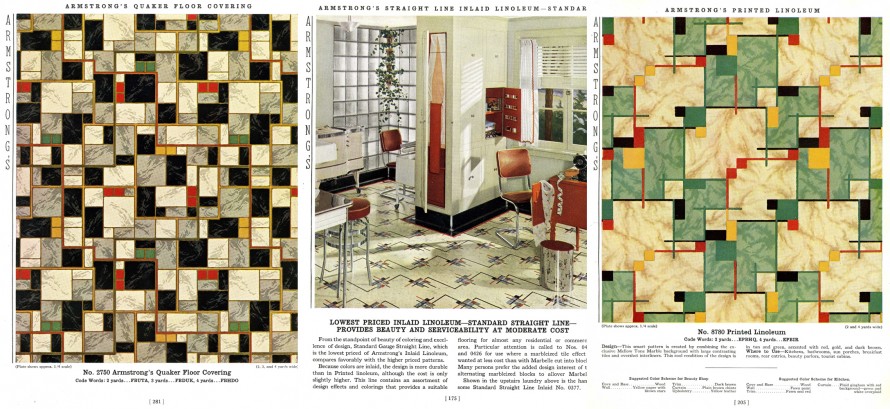Turning the pages of this 1939 Armstrong pattern catalog brings me back to when I first moved into my apartment. The floors in every room were covered in old-fashioned linoleum, with well-worn paths marking where people had walked over time. Of course, this all had to go, so I started tearing up the old linoleum only to uncover layer upon layer of different linoleum patterns and colors. Frustrated—but fascinated—it was déjà vu… the floors in my grandmother’s house, childhood visits running through the rooms in the homes of family and friends.

A “vegetable motif” pattern, geometric design, and a kitchen design using Armstrong linoleum flooring
First invented by Frederick Walton in 1860, linoleum is oxidized linseed oil mixed with ground cork dust, gums, and pigments. It was one of the most fashionable and widely used floor coverings from the 1870s through the 1960s. It was used everywhere from battleships to bathrooms.
The Armstrong Cork Company started manufacturing linoleum in 1908, and produced an amazing variety of patterns. By 1918, Armstrong advertised 380 available designs. These included mosaics, tiles, parquetries, granites, marble, and “carpet” patterns. This trade catalog from the Library’s collection documents the trends of styles and interior design of the 1930s and 1940s, and features modern geometric patterns along with traditional “homey” motifs and floral designs. The catalog shows patterns for every room in a house, and for anywhere else that linoleum might be the preferred flooring material.
Linoleum has remained fundamentally unchanged for one hundred years. Made from recycled materials and sustainable content, its “green” composition makes it as popular now as it was back in 1939. For years, linoleum was considered something to rip out in order to get down to the “real floor.” I know, I did it myself! I certainly never imagined these old flooring patterns would return to fashion as part of the popular “retro” look, or that linoleum would make a comeback.
Elizabeth Broman is a Reference Librarian at the Cooper Hewitt, Smithsonian Design Library.

13 thoughts on “Linoleum Lives On”
JHA Heath on March 11, 2016 at 2:26 am
Is it possible to PURCHASE one of these linoleum patters…I’m renovating my 1924 Craftsman home and want this look for the kitchen. Does any company make a “like” look in today’s market…that is $3.50 per sq. ft. or less. Marmoleum has one that’s close, Graphic, color Scrabble. I’m looking for a less expensive alternative but still having that “Look”
thank you, in advance, for your help.
JHA Heath
Stef on February 13, 2018 at 5:41 pm
No, linoleum like this does not live on, unfortunately.
Brenda Bullard on March 13, 2019 at 4:16 pm
BUMMER
Susan Bercu on May 31, 2016 at 11:44 am
My husband is going to lay linoleum tiles on our kitchen floor since there is no linoleum sheet large enough. I am going to create a design using a mix of colors of Armstrong Excelon tiles. Our local flooring company loaned me boxes of small samples so I can play with the amazing range of color choices. You can look on line but there are limited color options shown. Armstrong tiles are sold by the box and are about 90 cents a square foot. I’ve been advised against Marmoleum because it doesn’t have the lasting quality of Armstrong. I don’t intend to do anything as complicated as the retro designs on this page.
Rick Daly on April 16, 2019 at 10:47 pm
If no one can buy any of this linoleum , them why put something like this Cooper Hewitt Bull Sht on here ? waste of time !
Susan Werby on September 15, 2019 at 10:07 am
So angry? Maybe by bringing attention to cool stuff like this that is no longer being made, someone will decide to start making it again.
Debbie on February 27, 2020 at 11:35 am
Look under IVC sheet vinyl at home depot they a couple. this is a link to one of them.
https://www.homedepot.com/p/IVC-Soho-Blue-and-Grey-Residential-Vinyl-Sheet-Sold-by-13-2-ft-Wide-x-Custom-Length-C9695-360K574P158/303629952?MERCH=REC-_-searchViewed-_-308048121;303629952;308129718;308129727;308129710;303630769;308457927;303631428;308458199;308458369;308129725;308129691;308129690;308047609;308129703;308457921;308129719;308458494;308458183;308458892;308458458;308458375;308457915;308458985;-_-303629952-_-N
Mandi on April 11, 2021 at 1:23 am
I just tore out the floors of a house and discovered this fabulous vintage linoleum underneath. We found three patterns, all geometric. One pattern is sage green, black, red and cream. The others are shades of brown and black & red. It’s not salvageable as flooring but I plan on having my contractor cut out the better pieces of floor itself so I can clean them up and use them as art in my home. The colors are still fantastic. Prior to finding the old lino I had been looking for geometric floor tiles for my home that were very similar to the lino we found. I wish they still made flooring like this today!
Jodi on August 17, 2021 at 3:11 am
Congoleum still makes flooring like this and you can also do custom designs for their floors to create your own or replicate old patterns.
Nancy Webb on June 22, 2022 at 5:12 pm
Could you please send contact information. I am restoring a 1950s Spartan Aircraft camper and having a very hard time finding the linoleum. Will pay to have it replicated
Mickey on April 24, 2023 at 3:18 am
Please, PLEASE don’t ask someone to chop up old flooring. It’s PROBABLY FULL OF ASBESTOS. Go over it “as is” if you can. That’s safest.
CeLina Sumara on July 7, 2022 at 7:19 pm
Hi. This was found in our bathroom floor today. The entire flooring could not be saved but our contractor worked very hard to save these pieces for us. Our family home was built in 1921. I’ve been scannimg vintage samples online, hoping to identify the pattern with the goal of dating it. Any help or suggestions you can provide would be appreciated.
Kate Smith on August 30, 2023 at 6:00 am
Hi we’ve just uncovered an Lino rug by taking up carpet. Should we just throw away? It has a tear, but no bits missing.